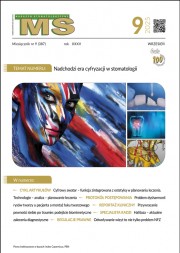Dostęp do tego artykułu jest płatny.
Zapraszamy do zakupu!
Po dokonaniu zakupu artykuł w postaci pliku PDF prześlemy bezpośrednio pod twój adres e-mail.
The analysis of RCI index among the people over 65 years old
Martyna Kowalczyk, Urszula Micińska, Sylwia Roguzińska, Katarzyna Skośkiewicz‑Malinowska,Barbara Malicka, Urszula Kaczmarek
Streszczenie
Wstęp. Zmiany występujące w jamie ustnej u osób w starszym wieku (m.in. recesja dziąseł prowadząca do ekspozycji cementu), trudności w utrzymaniu prawidłowej higieny z powodu upośledzenia umiejętności manualnych, odżywianie się miękkim węglowodanowym pokarmem, przyjmowanie leków obniżających wydzielanie śliny – stanowią ryzyko rozwoju próchnicy korzenia.
Materiał i metody. Badaniem klinicznym i kwestionariuszowym objęto 50 osób obojga płci powyżej 65. roku życia. Stan uzębienia w aspekcie próchnicy oceniano za pomocą lusterka i sondy WHO 621 w oświetleniu sztucznym według kryteriów WHO, obliczając wskaźnik PUW/Z, a próchnicę korzenia według kryteriów zmodyfikowanego wskaźnika RCI Katza. W badaniu ankietowym uwzględniono poziom wykształcenia, wysokość dochodu, obecność chorób ogólnoustrojowych i przyjmowanie leków oraz samodzielność w wykonywaniu codziennych czynności.
Wyniki. Wartość średnia wskaźnika PUW/Z wynosiła 25,92, w tym 13,54 zęba było usunięte. Wskaźnik RCI wynosił 33,31%. Wśród wszystkich obnażonych powierzchni korzenia 37% było objętych procesem próchnicowym, w tym 9% z nieleczoną próchnicą (RD), a 28% wypełnionych (RF).
Wnioski. W wieku powyżej 65 lat ponad 1/3 odsłoniętych powierzchni korzenia dotknięta jest procesem próchnicowym.
Abstract
Introduction. Among elderly people, changes that occur in oral area like the recession of gums which exposes the cementum, difficulties with maintaining proper oral hygiene caused by lower manual skills, eating pulpy and carbohydrated food, taking medicines which reduce saliva secretion increases the risk of root caries.
Materials and methods. The study group consisted of 50 people both genders over the age of 65 years. The examination consisted of non-invasive clinical examination with the use of periodontal probe and mirror as well as of survey. Dental condition was evaluated based on the DMFT index. In order to evaluate root caries, the four-point scale root caries index (RCI) was used. The questionnaire took into account the presence of systemic diseases, ingested medicines, income, education, and the level of independence of the respondents.
Results. The DMFT index was 25.92, with component M = 13.54. The mean value of RCI index was 33.31%. Among the exposed surfaces of the root up to 37% were recorded as a caries, including 9% of untreated (RD) and 28% filled (RF).
Conclusions. The obtained results of the RCI indices in the group of the elderly over 65 years old demonstrate the presence of root caries in over 1/3 exposed root surfaces.
Hasła indeksowe: próchnica korzenia, wskaźnik RCI, wiek starszy
Key words: root caries, RCI index, older age
PIŚMIENNICTWO
- Barzilain N. i wsp.: The critical role of metabolic pathways in aging. Diabetes, 2012, 61, 6, 1315-1322.
- Shaheen S.S. i wsp.: Oral health status and treatment need among institutionalized elderly in India. Indian J. Dent. Res., 2015, 26, 5, 493-499.
- Konopka T. i wsp.: Periodontal status and selected parameters of oral condition of Poles aged 65 to 74 years. Przegl. Epidemiol., 2015, 69, 3, 537-542, 643-647.
- Gluzman R. i wsp.: Prevention of root caries: a literature review of primary and secondary preventive agents. Spec. Care Dentist., 2013, 33, 3, 133-140.
- Chi D.L.: Correlates of root caries experience in middle-aged and older adults in the Northwest Practice-based REsearch Collaborative in Evidence-based DENTistry research network. Am. Dent. Assoc., 2013, 144, 5, 507-516.
- Fejerskov O., Kidd E.: Dental caries: The disease and its clinical management. Community Dent. Oral Epidemiol., 2004, 32, 236-237.
- Banting D.W.: The diagnosis of root caries. J. Dent. Educ., 2001, 65, 10, 991-996. Gerodontics, 1985, 1, 1, 20-27.
- Billings R.J., Brown L.R., Kaster A.G.: Contemporary treatment strategies for root surface dental caries. Gerodontics, 1985, 1, 1, 20-27.
- International Caries Detection and Assessment System Coordinating Committee. Appendix Criteria Manual International Caries Detection and Assessment System (ICDAS II) Workshop held in Baltimore, Maryland, March 12th-14th 2005.
- Katz R.V.: Assessing root caries in populations: the evolution of the root caries index. Public Health Dent., 1980, 40, 1, 7-16.
- Rocznik demograficzny 2016. Główny Urząd Statystyczny, Warszawa 2016. Źródło: http://stat.gov.pl/obszary-tematyczne/roczniki-statystyczne/roczniki-statystyczne/rocznik-demograficzny-2016,3,10.html
- Ryu M.: Oral environmental factors affecting number of microbes in saliva of complete denture wearers. J. Oral Rehab., 2010, 37, 3, 194-201.
- Millsop J.W. i wsp.: Etiology, evaluation, and management of xerostomia. Clin. Dermatol., 2017, 37, 5, 468-476.
- Finbarr Allen P., Sinclair McMillan A.: A review of the functional and psychosocial outcomes of edentulousness treated with complete replacement dentures. Can. Dent. Assoc., 2003, 69, 10, 662.
- Warren J.J. i wsp.: Dental caries prevalence and dental care utilization among the very old. Caries Res., 2004, 38, 333-340.
- Splieth Ch. i wsp.: Prevalence and distribution of root caries in Pomerania North-East Germany. Caries Res., 2004, 38, 333-340.
- Imazato S.: Prevalence of root caries in a selected population of older adults in Japan. J. Oral Rehab., 2006, 33, 137-143.
- Mariño R.J., Fu C.S., Giacaman R.A.: Prevalence of root caries among ambulant older adults living in central Chile. Gerodontology, 2015, 32, 2, 107-114.
- Skrzypkowski A.: Wybrane problemy stomatologiczne ludzi starszych. Współcz., 2003, 10, 3, 49-53.
- Mamai E. i wsp.: Risk indicators of coronal and root caries in Greek middle aged adults and senior citizens. BMC Public Health, 2012, 12, 484.
- Jiang H. i wsp.: Root caries patterns and risk factors of middle-aged and elderly people in China. Community Dent. Oral Epidemiol., 2009, 37, 260-266.














